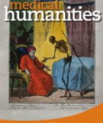Are they friends or not? Just a second of laughter can reveal relationship status
An international team of researchers - 3 of which part of IMC - built a network of participants across 24 cultures to answer the question: can we assess whether people are friends or strangers by the way they laugh together? The answer is yes. Participants across the world, from urban USA to hunter-gatherer tribes in Tanzania, can all recognize friends from strangers above chance.

The study was published on Monday in the Proceedings of the National Academy of Science (PNAS). The lead author - Gregory Bryant from UCLA - collected recordings of college students laughing together during natural conversations. Half of the students were friends, others did not know each other in advance. These recordings were then used in a cross-cultural experiment. Researchers around the world presented volunteers with the recorded laughs and asked them to guess whether the laughers were friends or not. “24 cultures and languages were tested: from college students in Los Angeles to indigenous tribes in New Guinea, passing by volunteers here in Aarhus, Denmark” says Michael Bang Petersen, a IMC researcher, who together with Lene Aaroe ran the experiment on Danish participants.
The results show that all cultures and languages can effectively discriminate between friends and strangers, using even minimal social signals: some of these laughs are shorter than 1 second.
“These findings point to a widespread mechanism to navigate the social world” explains Riccardo Fusaroli - the IMC researcher who analysed the acoustic properties of the laughs - “Humans’ incredible success as a species relies on the ability to cooperate with others. However, cooperation has risks: other people might exploit your efforts and not give anything back. So, in order to benefit from cooperation humans need to be able to assess and signal alliances and willingness to cooperate”. The results, thus, suggest that as a species we are especially attuned to the social information contained even in minimal signals, and that ability might make cooperation easier and more effective and therefore it was selected via natural selection.
Further analyses were employed to identify the specific acoustic cues that participants were using to assess the social context of the shared laughs. Participants seem to use very low-level acoustic properties, such as jitter, which are not under direct control of the laugher and therefore harder to fake.
The study combines deeply humanistic questions about the meaning of laughter in interaction with experimental methods from cognitive and social sciences and signal processing techniques from engineering and computer science. This sort of interdisciplinarity is remarkable and lies at the core of the Interacting Minds Center and the recently established Bachelor in Cognitive Science at Aarhus University.
--
To read the paper:
Gregory A. Bryant, Daniel M. T. Fessler, Riccardo Fusaroli, Edward Clint, Lene Aarøe, Coren L. Apicella, Michael Bang Petersen, Shaneikiah T. Bickham, Alexander Bolyanatz, Brenda Chavez, Delphine De Smet, Cinthya Díaz, Jana Fan?ovi?ová, Michal Fux, Paulina Giraldo-Perez, Anning Hu, Shanmukh V. Kamble, Tatsuya Kameda, Norman P. Li, Francesca R. Luberti, Pavol Prokop, Katinka Quintelier, Brooke A. Scelza, Hyun Jung Shin, Montserrat Soler, Stefan Stieger, Wataru Toyokawa, Ellis A. van den Hende, Hugo Viciana-Asensio, Saliha Elif Yildizhan, Jose C. Yong, Tessa Yuditha, and Yi Zhou
Detecting affiliation in colaughter across 24 societies
PNAS 2016 ; published ahead of print April 11, 2016, doi:10.1073/pnas.1524993113
--
Link to the video about the laughter Study: https://t.co/DVxQ0L2TIE
--
Media coverage:
Videnskab.dk - Latterforskning: lyden afslører, om I er venner
--
Contact information:
Assistant Professor Riccardo Fusaroli, School of Communication and Culture and IMC



